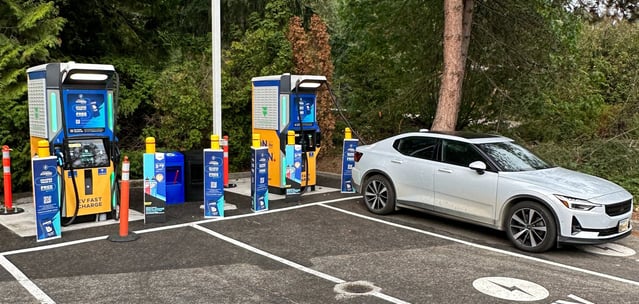
Unpopular Opinion - Level 3 EV Chargers Will Soon Be Obsolete
Do not invest in Level 3 EV Chargers. You’ll lose all your money.
ENTREPRENEURS


Are Level 3 EV Chargers a Good Investment?
Introduction
Soon, the speed of EV chargers won't matter. Hear me out.
Lots of people are considering how to make money from the EV charging market. I get many questions about the best way to profit because there are so many angles. There are so many lanes to be creative and position a business opportunity that it's hard to know where to start. Level 3 EV Chargers are a hot topic. They seem to be very popular amongst EV drivers and in turn, look to be an appealing business opportunity. Many people ask me if this is an advisable business venture.
I usually explain the concept in more detail and note what to look out for. As more people are expressing interest in investing in Level 3 EV Chargers, it's got me thinking. In the short term, they seem to be promising if you do it right, but is this really a wise investment for the long term? Here's what I've been thinking.
Aspects of Investment
Something that I've been pondering lately is the long-term demand for Level 3 EV Chargers. Some people, who have deeper pockets than others, are considering investing in Level 3 EV Chargers. These chargers require a much greater capital investment for many reasons. You're most likely going to need to purchase the property underneath the chargers, figure out a way to get the city to allow you to bring in 400 kW or more of power, as well as pay for the chargers themselves. At a minimum, I'd say you're looking at $200,000 just for the Level 3 EV Chargers. This doesn't include the cost of the real estate property.
Long Term
But what happens in 5 or 10 years when people don't even need Level 3 EV Chargers anymore? Did these entrepreneurs just waste a bunch of money investing in a business that's about to become obsolete? These are some things that have crossed my mind lately, so let's explore what led me to this opinion.
Supply & Demand
The reason Level 3 EV Chargers are so valuable is because chargers of any type are hard to find. The demand is so high for EV charging because the supply is so low. It’s getting better but it's still hard to find EV chargers these days. When drivers do find one, they want to consume as much electricity as possible because they're not sure when they’ll find another charger again.
Increase Supply
But what happens when there are chargers everywhere? If there is an EV charger in every parking stall where you leave your car, will there be any point to Level 3 EV Chargers anymore? Theoretically, if the city is following the regulations of the British Columbia government, soon there will be chargers everywhere. Availability will be through the roof. Every parking stall will have an EV charger. Wherever you leave your car, there will be an EV charger.
Decrease demand
This may be years down the road, but think about it. If you have a charger at home, a charger at work, and a charger at the grocery store, and every time you park your car you automatically start charging, then won't your car be basically fully charged all the time? You could have slow chargers everywhere and as long as people are consistently using them wherever they go, their cars are usually fully charged. Therefore, there won't be a need for Level 3 EV Chargers.
My iPhone Chargers
The days of praying for a nearby Level 3 EV Charger will soon be a thing of the past. There will also be no need for long wait times to charge your car.
In my apartment, for example, I have iPhone chargers everywhere: both sides of my bed, both ends of my couch, and the moment I get to work, I have another one at my desk. I can't remember the last time my phone dropped below 70%. There's never a time when I let it run down to 20% and hope I'll find a super-fast iPhone charger to get it back up above 80% before I go out to meet my friends. It just doesn't happen because iPhone chargers are everywhere. Even if they're slow, their availability cancels out the need for them to be fast.
More Efficient Batteries
Over time, electric car batteries will become much more efficient. They will require less electricity to travel further distances. For the sake of round numbers, currently, a Tesla Model 3 requires almost 60 kW to travel 400 kilometers. But what happens when the batteries improve and that same 60 kW provides enough power for the car to travel 800 kilometers? Will there ever be such a desperate time where the driver needs to quickly power up from 20% to 80% to feel confident about getting back on the road again?
No More Range Anxiety
To continue the thought above, a full battery providing 800 KM would almost completely remove all concerns about running out of power. That's like driving from Vancouver to Kelowna and back without having to charge your car once. And then when you get home, you just plug your car into your Level 2 EV Charger in your garage and you're good to go for the next morning when you wake up for work. Even if your car isn't fully charged, there will be another charger waiting for you at work.
Load Sharing
This is where load sharing will significantly come into play. Load sharing is actually an effective idea once there are chargers everywhere. Right now, people complain that load sharing is inefficient because it divides the power among multiple chargers. This means instead of having one fast charger, you have four slower chargers. I can see how this would be frustrating if the next closest charger to you is 30 km away. However, if there is a charger at every single place you park your car, then it really doesn’t matter how slow the chargers are, as you're constantly plugged in everywhere you go.
Slow Chargers will be Welcomed
This solves the problem of buildings not having enough power to install 10 kW chargers in every parking space because cars will almost always be above 50% charged. Even if there are 100 chargers only putting out 3 kW, it won't matter because EV’s will only need a slight top-up in power. If you have 3 kW chargers in every parking space, cars should have sufficient power to keep their batteries charged enough to get where they need to go. It's just about topping up the car's power a bit to get to the next place they park.
Plug and Charge
You might wonder how inconvenient it will be to plug in an EV charger, pull out your phone, initiate the charge, and pay for it every time you park your car. However, technology is advancing rapidly, and something called "plug and charge" is just around the corner. With plug and charge, all you'll need to do is take the cord from the EV charger and plug it into your car. Your car will contain all the authentication information for your identification and payment. Once the cord is plugged into your car, the charge will initiate on its own. It will become as second nature as turning off your car or closing your door. Before you walk away from your car, you will have already plugged in the EV charger without even realizing it.
Conclusion
In conclusion, the future of EV charging isn't about faster speeds, but about the abundance of charging points and efficient battery technology. As EV’s become more mainstream and charging infrastructure improves, Level 3 EV Chargers could become obsolete. Just like with my iPhone, the availability of charging points will negate the need for super-fast charging. As we move towards this future, investing in Level 3 EV Chargers might not be the cash cow it appears to be today. So maybe it's time to rethink our charging strategies and aim for coverage over speed. After all, what's the rush if you're always topped up?
You've heard it before and I'll say it again. Please use me as a resource and reach out if anything comes to mind. I'm here to help.
Take it easy,
Strong Energy










